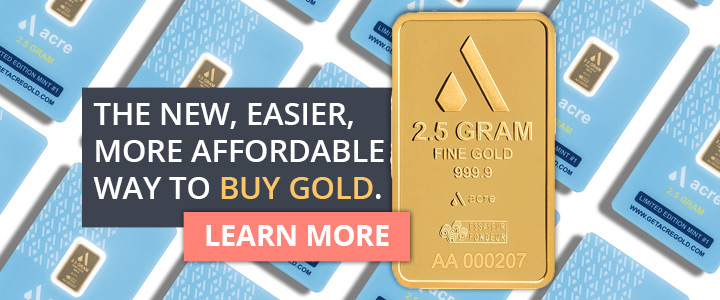Pros and cons of physical gold
For many people, the whole point of owning gold is to own the physical stuff. It’s the actual metal that has most of the inherent investment advantages.
Advantages of physical gold
- Inflation hedge. Advocates argue that, as a tangible asset, gold maintains an intrinsic value that always reflects the cost of living. There’s an old saying that an ounce of gold equals the cost of a quality business suit. That held in 1934 when men’s suits fetched $35, and it does today too, with gold close to $2,000 an ounce (of course, that suit better be a Boglioli).
- Counterweight to stocks. Like other commodities, gold acts as a counterfoil to equities, usually moving in the opposite direction of the stock market. Case in point: When the subprime mortgage meltdown began in 2008, ushering in the Great Recession, gold—which for years had been trading in the $400-600 range—shot up to $1,000 per ounce and kept going for the next three years.
- Safe haven. Gold’s seen as a safe haven in uncertain times or whenever there’s socio-political turmoil. After the 2016 Brexit vote, its price rose over 10% in one month, for example. “Owning gold,” says Dennis Notchick, a certified financial planner at Stratos Wealth Advisors, “appeals to individuals who are concerned about the collapse of global markets or other threats to a government’s ability to back its currency.”
- Virtually indestructible. “Physical gold cannot be hacked or erased,” says Charles Stevens, COO of Bullion Box Subscriptions. (Remember, we’re thinking in catastrophic terms here.) “Gold cannot be destroyed by a natural disaster and it will not get worn down in time.”
Drawbacks of physical gold
- Expensive to hold. Storing gold at home carries enormous risks of theft or loss. Keeping it in a commercial facility incurs storage costs, often based on the size and value of the holdings (anywhere from .5% to 2%). If you’re not using a professional storage facility, you’ll want to insure your gold, too — another ongoing charge.
- Illiquid. Physical gold can’t be sold with a press of the button or a call to a broker. Even with dealers acting for you, a sale can get days or weeks to settle, plus you have to arrange for shipping.
- Does not produce income or profit. A $1,000 investment in bullion buys $1,000 — period. Physical gold doesn’t generate interest or dividends. The only potential for appreciation is if there’s a jump in prices that lets you sell at a profit (and even that can be compromised by the time, effort, and various assessment costs that accompany selling).
How to invest in gold securities
Given the hassles and limits of bullion, gold securities — in the form of stocks, funds, or options — are often a better choice, especially for novice investors.
They may not be as pretty, but they’re infinitely more practical:
Gold stocks
Buying shares of companies in the mining, refining, or other aspects of the gold production business is one way to play. About 300 of these companies, aka “miners,” are listed on major stock exchanges. Their share prices generally reflect the movement of the metal itself. However, “the growth and return in the stock depend on the expected future earnings of the company, not just on the value of gold,” notes the World Gold Council, an industry trade group.
Gold ETFs and mutual funds
More conservative investors can buy shares in gold-oriented mutual funds or exchange-traded funds (ETFs). These funds have varying investment approaches: gold-backed ETFs tend to invest directly in physical gold, while mutual funds favor gold mining stocks. Some funds invest in both. But all offer a liquid, low-cost entry into the gold market that is more diversified, and so lower-risk, than buying equities outright.




